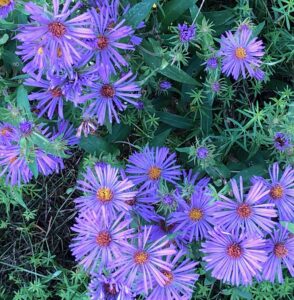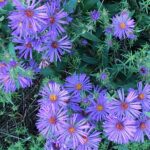 This is the time of year when clusters of small daisy-like blooms dot the landscape. Some are tiny and ghostly white, more froth than flower; others the size of half dollars with bright periwinkle petals and chrome yellow eyes. The Berkshires alone boasts more than 20 species of wild asters (Latin for “star”) and there are several hundred known varieties around the country. Like Japanese Anemone and Sweet Autumn Clematis— other late bloomers — most asters seem too delicate and ethereal to stand up to Fall’s sinking temperatures and rising winds. But they do — and put on quite a show in the bargain. Though many of the New England asters I’ve tried to introduce into
This is the time of year when clusters of small daisy-like blooms dot the landscape. Some are tiny and ghostly white, more froth than flower; others the size of half dollars with bright periwinkle petals and chrome yellow eyes. The Berkshires alone boasts more than 20 species of wild asters (Latin for “star”) and there are several hundred known varieties around the country. Like Japanese Anemone and Sweet Autumn Clematis— other late bloomers — most asters seem too delicate and ethereal to stand up to Fall’s sinking temperatures and rising winds. But they do — and put on quite a show in the bargain. Though many of the New England asters I’ve tried to introduce into  my garden haven’t thrived, I’ve had good luck with the cultivated variety ‘Alma Potschke’ (pictured at right) whose vibrant crimson blooms light up the back of the border straight through until the first hard frost.
my garden haven’t thrived, I’ve had good luck with the cultivated variety ‘Alma Potschke’ (pictured at right) whose vibrant crimson blooms light up the back of the border straight through until the first hard frost.
We had the upper field mowed last week, and I thought of this poem by Robert Frost and his apt description of “the headless aftermath.” Read this lovely lament for summer’s passing, and you’ll find an aster waiting for you at the end.
A Late Walk
By Robert Frost
When I go up through the mowing field,
The headless aftermath,
Smooth-laid like thatch with the heavy dew,
Half closes the garden path.
And when I come to the garden ground,
The whir of sober birds
Up from the tangle of withered weeds
Is sadder than any words.
A tree beside the wall stands bare,
But a leaf that lingered brown,
Disturbed, I doubt not, by my thought,
Comes softly rattling down.
I end not far from my going forth
By picking the faded blue
Of the last remaining aster flower
To carry again to you.




Beautiful. I had not remembered this poem of Frost’s.
I agree. The poem has such a quiet sadness and resonance. Thanks for writing!
beautiful. I love this poem so powerful just now as well.
Thanks, Gwen!
I have enjoyed the asters every fall in Prospect Park. I bought a couple for my “pots” garden in from of the building. Unfortunately, they quickly browned but are still surviving. Thanks for the Frost poem– so evocative in that understated way of his.
I’ve noticed that aster stalks tend to wither and brown early, so it’s best to put them in the back with something bushy in front. But the flowers keep going forever and look great even as they die back.
Dear Liza,
Love this poem, what a pleasure to be introduced to it.
Thanks so much.
Beata
Thanks, Beata. I love Frost’s “walking” poems. Remember this one? I always feel invited along in his poems. –Liza
The Pasture
I’m going out to clean the pasture spring;
I’ll only stop to rake the leaves away
(And wait to watch the water clear, I may):
I sha’n’t be gone long.—You come too.
I’m going out to fetch the little calf
That’s standing by the mother. It’s so young,
It totters when she licks it with her tongue.
I sha’n’t be gone long.—You come too.
Lovely poem and photos! Appreciate your sharing!
Thanks so much for writing, Claudia!
My field also got plowed this week. It’s such a definitive sign that summer is over — though this summer was such a bizarre one. I love seeing the diminutive asters as I walk my dog, Bentley in TurnPark. The Frost poem capture my mood so perfectly.
I love the “again” in the last line of the poem — the fact that he goes for this walk year after year and remembers his wife each time. They had a long marriage with much heartache, apparently, but I often sense that he’s addressing her in his poems.
Yes, aren’t the wild native asters lovely – so welcome this time of year.
Yes, I found the periwinkle ones I photographed at Siegel-Kline Kill in Columbia Country a few weeks ago. We walked there yesterday and they’re still going strong!
Liza, what a lovely post.
I love how these bright little fall flowers hang on for dear life. I always have a hard time
letting go of summer too! Frost so perfectly describes the melancholy mood of summer ending and slipping into Fall.
xxKate
Thanks, Kate. I know what you mean, but it helps that the fall can be so beautiful, too. We’re seeing bright red flares in the maples now.
XxxLiza